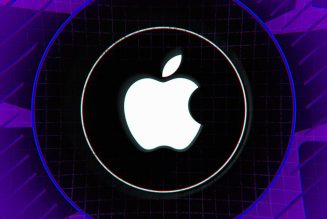When the Tidbyt, which its creators describe as a “personal pixel display,” arrived at my house, I liked it before I even knew what to do with it. With its walnut paneling and its ultra-pixelated display, it kind of looks like what would happen if you asked someone in 1956 to design an Echo Show for Amazon. It’s 8.2 inches long, 4.4 inches tall, and two inches deep, which is a little big to put on your bedside table but nestles nicely into a bookshelf or on a larger desk. It’s an impressively well-made thing for a company’s first product.
But the thing about the $179 Tidbyt is that it never really becomes obvious what this device is for. It’s a clock but not an alarm clock. It’s a hilariously bad digital photo frame. It doesn’t do anything your phone can’t, and your phone definitely does all those things better. It’s an excellent delivery system for quick bits of ambient information, but if that doesn’t immediately mean anything to you, you don’t need a Tidbyt. Its charm is real and still hasn’t worn off on me, but it still feels a bit unfinished.
The team behind Tidbyt started working on this a couple of years ago and launched the product on Kickstarter in March 2021. A year and a half later, all the backers have received their Tidbyts, and the device is generally available. Sort of: co-founder Rohan Singh tells me the current supply is sold out, but “we have more units on the way in a couple of weeks.” Manufacturing is hard, but Singh is confident Tidbyt can stay on top of things.
There are plenty of hints that Tidbyt is still new at this, though. For starters, my device arrived with an Anker-branded charging cable in the box along with a black wall plug that clearly came out of a bin somewhere in a factory in China. Neither of those bothers me, really — and at least the cable is one of those nice braided ones — but an Apple-like unboxing experience this is not.
The screen is the whole point of Tidbyt, though, and it’s a very unusual one. It’s not a screen so much as a collection of individual LEDs — 64 across by 32 down, 2,048 of them in all — that can be lit up and controlled individually. You can control the display’s brightness, and it can get seriously bright; I kept the brightness level at about 15 out of 100, and at full strength, those 2,048 LEDs were bright enough that the Tidbyt lit my home office practically by itself.
:no_upscale()/cdn.vox-cdn.com/uploads/chorus_asset/file/23941426/DSC01666.jpeg)
It’s incredibly low-res by design because it’s not meant to do very much. The Tidbyt’s makers aren’t trying to build a super immersive gadget but, rather, something that can keep you from needing to look at your phone every time you need a tiny bit of information. Singh says that he built the original prototype as a way to quickly find out when the subway was coming. “If I got on my phone to check,” he says, “then I would also check Twitter. And I would check Instagram and stuff, and then just be doing that for, like, half an hour.” Instead, he hacked together a thing that plugged into the New York City’s subway API and told him when the next G train was arriving. It looks like a subway status board because that’s exactly what it is.
There’s a whole genre of gadgets out there that all pitch themselves this way, of course. “This is the gadget that will free you from your phone” applies to everything from the Apple Watch and Alexa to the minimalist smartphones from Palm and others. Tidbyt just takes the idea to its extreme by not letting you interact with the device at all.
:no_upscale()/cdn.vox-cdn.com/uploads/chorus_asset/file/23941423/DSC01779.JPG)
To set up the Tidbyt, you just plug it in. It turns on automatically and jumps into pairing mode. All the actual work happens in the Tidbyt app, which is available on Android and iOS: you connect to the Tidbyt via Bluetooth then log it into your Wi-Fi network and it’s up and running. The app is where you decide what the Tidbyt will do, how bright it gets, and everything else. It does defeat the whole “don’t use your phone” idea a bit, but once the Tidbyt is set up the way you like it, you don’t really need the app anymore.
As for getting stuff on the Tidbyt, that happens in the app as well. There’s a store with a few dozen different apps, all of them free, which you can install on your device in a couple of taps. Most are status boards of some kind: there are lots of different clocks, a bunch of weather apps, ways to track the stock market or the price of Bitcoin or the phase of the Moon, some sports score apps that scroll like the ESPN ticker, and plenty of ways to see when the next subway train is coming. There are a few silly apps, too, like a Nyan Cat animation or a recreation of the bouncing DVD logo that I am not ashamed to admit I watched for about 20 straight minutes just to see if it would ever hit the corner. (It did, and it was awesome.)
More apps are coming to Tidbyt all the time, but it’s still pretty basic. There’s no calendar app that works for Outlook or iCloud, for instance, nor is there a way to see most to-do lists other than from Todoist or Things. Building an app for Tidbyt is fairly straightforward — it’s just a bunch of lights, after all, and if you have access to Linux and basic Python knowledge, you can write your own pretty easily. And the Tidbyt team tells me they’d ultimately like the Tidbyt to work more like a no-code platform for anyone to create custom apps. That’s still a ways off, though, and for now, there are big holes in the app store.
It’s easy enough to add apps to your Tidbyt, but I wish I could do more to manage them. By default, the Tidbyt rotates through all the apps you’ve installed, displaying each one for 15 seconds at a time. You can drag the apps around to determine the order in which they show up, and you can shorten the switching time down to as little as five seconds, but you can’t make it any longer — and I want it to be longer. More than that, what I want is a way to freeze it on a single app, kind of like hitting “hold” on a thermostat to keep it at one temperature rather than running the normal schedule. You can technically schedule when apps do and don’t run, so you can kind of reverse engineer this setup, but it’s a lot more work than it should be.
Without this kind of control, you’ll really only want to add apps to the Tidbyt that you plan to use all the time. I ride the DC metro sometimes but not daily, and it got annoying constantly looking at the schedule on days I didn’t care. Nyan Cat was funny — but not enough to look at once a minute 24 hours a day.
In my whole time using the Tidbyt, I’ve vacillated constantly between appreciating how little it does and wishing it would do just a tiny bit more. It’s a great-looking desk clock and, with a speaker, would be a great alarm — but I don’t really want this thing shouting at me all day. It’d be nice to be able to scroll through my apps manually, but I also don’t want to turn my Tidbyt into a thing I have to walk over and interact with.
:no_upscale()/cdn.vox-cdn.com/uploads/chorus_asset/file/23941417/DSC01852.JPG)
Here’s where I landed: a button. I wish the Tidbyt had one, single, customizable, smackable button on the top. That button could be totally programmable — both the hardware and the software are easy to pull apart and tinker with, which Singh told me is a key part of its purpose — but I’d use it just as a way to stop and start the Tidbyt’s app rotation: one smack to freeze it on whatever app is currently showing so I can just have the clock and forecast showing most of the time, another smack to start it cycling between everything I have installed.
I don’t think I’m getting my button anytime soon, but the Tidbyt team is working on some more controls for the software. “Right now, it’s definitely limited,” Singh says, “but it’s simple. It’s very predictable. There’s a lot of things we can do, like add scheduling, or allow you to hold an app or change the amount of time one app is displayed — the question is how to do that and give you a user experience that makes sense.” The whole point of the Tidbyt, he says, is that you don’t have to use it for it to be useful, and he doesn’t want to lose that.
The other thing missing from Tidbyt right now is multiuser support. For a device that’s likely to be placed around people’s homes, the fact that you can only control it from a single phone is a problem. The team says it’s working on that, too, as well as better controls for homes with multiple Tidbyts.
After a few days of playing around with all the Tidbyt apps, I ended up keeping just three: one shows the forecast; one shows the next event on my calendar; and one is a delightfully pixelated picture of my two dogs. The Tidbyt flips between them every 15 seconds.
As a result, my Tidbyt is basically a super-powered desk clock. $179 is an awful lot to pay for a super-powered desk clock, of course, and it doesn’t offer anything you can’t get with a quick glance at your phone. It also offers a lot less than you’d get from a smart display from Google or Amazon, many of which you can find much cheaper. But I like the idea of these light, ambient gadgets, which have information I need but don’t thrust it in my face with push notifications or try to lure me into doomscrolling every time I look. I like what the Tidbyt represents even more than I like the device itself. I don’t even want it to do more stuff! I just want to control it better.
Photography by David Pierce / The Verge








